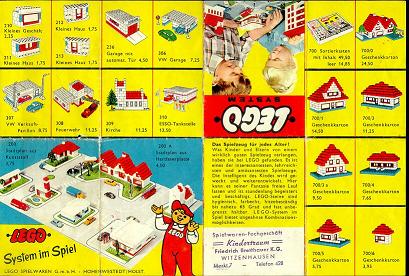Using a LEGO plate when you play with LEGO is not just to attach the bricks. It also makes the lego built looks nicer and more attractive.
In the long history of LEGO, there have been many plates produced by the LEGO company. Let’s take a look at the history of LEGO plate.
We can trace back to the very beginning of Lego sets (circa 1956). The plates were only produced in white in sizes 2×8, 4×8, 6×8, and 4×8 – right curve, and 4×8 – left curve by then. It was like that until 1963. These early plates had those interesting “square holed” bottoms, and were made of Cellulose Acetate (as were all the other Lego bricks). The 1950’s and 1960’s Esso Service Station (#310) were an early user of all of these plates, especially the curved plates. In fact the Esso Service set had red “hand painted” edges on some of these plates to give that “Art Deco Moderne” red stripe that this set had. Horst Lehner’s excellent website of early Lego Catalogs shows (in the 1958 catalog) the red striped plates in the Esso Service set:

This red stripe (the Esso Service station) was also found in the early Samsonite Town Plan set (#725), as well as the European Town Plan set (#810).
The first small Lego plates came out in a big way in 1963. That year several very interesting thing happened:
1) small plates (1×1, 1×2, 2×2, 2×3, 2×4) came out for the first time in parts packs.
2) small plates were used for the first time in a set – the unique continental European Architectural Sets.
3) small plates did not have the “square hole” bottom common to the larger white plates, but the circular holes like we know them today.
4) Samsonite produced small plates in different colors (white, red, black, grey, clear, green) than were available in Europe (white, red, yellow, blue, black, grey, clear). Green was only produced by Samsonite, and blue & yellow were only produced by TLG Europe.
5) TLG (Europe) produced plates from the very beginning (1963) in ABS Plastic, while Samsonite (USA/Canada) produced small plates (also starting in 1963) in Cellulose Acetate! Figure that one out!
The first plates parts pack that came out in 1963 came out in several very interesting variations. The regular European parts packs of 1963 were colorful boxes slightly larger than USA cigarette boxes, and had flapped ends for opening the box (as opposed to the earlier sliding open box, similar to match boxes – which were used for parts packs from 1956-62). The new plate boxes were the same as other Lego brick boxes. They were #518 (2×4 plates), #519, (2×3 plates), #520 (2×2 plates), and #521 (1×1 & 1×2 plates).
A 1963 German catalog (from Horst Lehner’s ) showing the small plates for the first time:

These 4 parts packs was the Architectural series of parts packs that had the same set number (and the same number of pieces) as the regular plates parts packs. The major difference for these Architectural parts packs was that they were encased not in cardboard, but in a clear plastic box that had a 8×11 grey plate as the bottom of the box, with a cardboard sleeve (showing “architects” and young adults building modern houses and buildings). This 8×11 grey plate was the very first large Lego plate produced in a color other than white. It is also, believed, the only time an 8×11 rectangular plate was ever produced by Lego.
These Architectural parts packs were produced for the short lived (and not too popular) Architectural Series of sets – #750, #751, #752. This entire Architectural series (plus their parts packs) were only produced
for the continental European countries (not Britain), and were produced from 1963-65.
By that time, Samsonite was only using Cellulose Acetate bricks for the material, then it must have switched to ABS plastic after TLG Europe (which started switching in 1961 – according to “The World of Lego Toys”).
Plates in other sizes that those listed above would come later, and by the 1990’s plates would come in all shapes and sizes.
This LEGO plate history was a write up by Gary R Istoc
What is Samsonite to do with LEGO?
We all know that LEGO was founded in Denmark. By the mid 1950’s, it was sold throughout the Scandanavian countries of Europe. In 1956 it started selling in West Germany, Europes largest market. By the early 1960’s The LEGO Group (TLG) wanted to expand to the USA and Canada. However, the market was to big for them and had them formed a licensing partnership with the Samsonite Corporation of Denver Colorado. The license (as was just stated by Anders Isaksson of Sweden) was for 99 years, although TLG purchased back the license in 1972. So between 1961 and 1972 all US Lego boxes said “LEGO by Samsonite”.